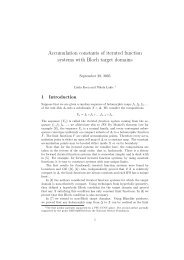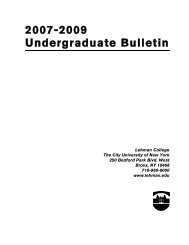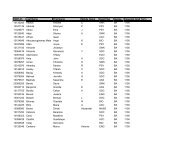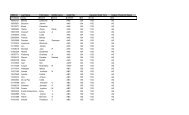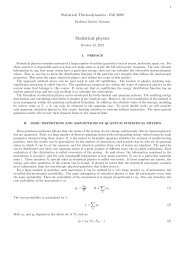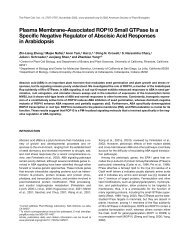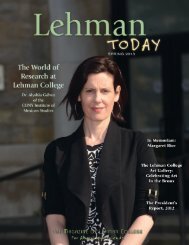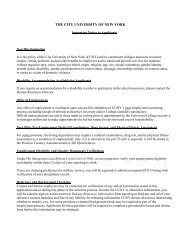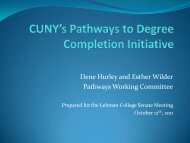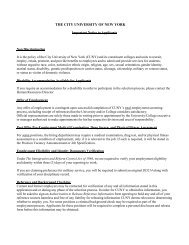Create successful ePaper yourself
Turn your PDF publications into a flip-book with our unique Google optimized e-Paper software.
Speaking for the Vi ct<br />
Investigating a 1978 Massacre in Guatemala<br />
Photo by Larry Kaplow<br />
Dr. Victoria Sanford, an associate professor of anthropology at<br />
<strong>Lehman</strong>, has been a John Simon Guggenheim Fellow (2009), a<br />
Fulbright Fellow, and a Senior Research Fellow at the Institute on<br />
Violence and Survival at the Virginia Foundation for the Humanities.<br />
In <strong>2011</strong>, she became the founding director of <strong>Lehman</strong>’s<br />
new Center for Human Rights and Peace Studies. This article is<br />
excerpted from a paper she delivered last year at the 55th Annual<br />
Meeting of the Society for Ethnomusicology.<br />
As an anthropologist and human rights<br />
advocate, I accompany massacre survivors seeking justice in the<br />
communities where I work and try to make scholarly contributions<br />
that support their pursuit of justice. In 1997 and 1998, I directed<br />
the historical research to reconstruct four army massacres for the<br />
Guatemalan Forensic Anthropology Foundation’s (FAFG) report<br />
to the CEH (the Guatemalan Truth Commission). The incident<br />
under investigation was the 1978 Panzós plaza army massacre of<br />
Q’eqchi’ Maya peasants. We gathered nearly 200 testimonies from<br />
massacre survivors and witnesses, reviewed municipal archives and<br />
death registers, and conducted an exhumation of the mass grave<br />
of victims. In 2010, I returned to Panzós to commemorate the 32nd<br />
anniversary of that massacre.<br />
August 1997:<br />
The Forensic Team Meets the Community<br />
Nineteen years after the massacre, the FAFG and the regional<br />
prosecutor from the departmental capital and his assistant traveled<br />
to Panzós to carry out a preliminary site visit to gather information<br />
for the forensic investigation and the legal proceedings planned<br />
by the prosecutor. When we reached Panzós, more than 200<br />
widows ranging in age from 35 to 70 were waiting for us at the<br />
entrance to the cemetery. The median age was probably about 60.<br />
The younger women ranged in age from 40-50. Conspicuously<br />
absent were 45- to 60-year-old men. These missing men were the<br />
victims of the plaza massacre and the wave of disappearances and<br />
assassinations that followed. At the top of the hill, a whitewashed<br />
cross made of railroad ties marked the grave. Almost immediately,<br />
the widows began to give testimony about the day of the massacre<br />
and collectively wept.<br />
A young woman named Maria spoke firmly, but wept as she recounted<br />
her survival and how, at the age of 12, she had witnessed<br />
the killing of her grandmother, Mama Maquín. “I saw people dying<br />
there,” she declared. “They were falling. There were some who fell<br />
on top of me, and bullets flew by my face. I threw myself on the<br />
ground. I was face down and pretended to be dead. And there I<br />
was, mixed in with those who had stopped moving.”<br />
16 <strong>Lehman</strong> Today/<strong>Spring</strong> <strong>2011</strong><br />
Everyone began to step forward, wanting to give testimony about<br />
the massacre. We explained that we would carefully listen to<br />
each of them when we returned to carry out the exhumation. En<br />
masse, we then went to a small, dark community building to explain<br />
the exhumation process and to answer any questions about the<br />
process. At the end, several dozen people stood up, holding the<br />
identification papers of their dead and disappeared loved ones, and<br />
expressed their desire to begin the identification process right then<br />
and there.<br />
September 1997:<br />
Testimony and the Excavation of Memory<br />
Two months later, on our return to Panzós to begin the exhumation,<br />
those same widows were waiting for us. We set up two private corners<br />
within a nearby house, set on a little hill above the cemetery.<br />
A thatched roof rested upon the walls of wood slabs and bamboolike<br />
sticks. The dirt floor was swept clean. In one corner was a bed<br />
of plywood slats. A hammock hung diagonally across the room.<br />
Against the wall, facing the door, was a small table covered with a<br />
piece of floral plastic. Candles, a few flowers in a cola bottle, an image<br />
of a saint, and old tin cans blackened by smoke from incense<br />
transformed the humble table into an altar. A plain wood-slab table<br />
and bench became our workspace.<br />
For nearly three weeks, we interviewed daily from 7 a.m. to 6:30<br />
p.m., often without taking a break. The number waiting never<br />
seemed to diminish. They left their work in the fields to wait all day,<br />
sitting patiently in the heat, without food or drink, just waiting for<br />
their turn. In all, we interviewed almost 200 people.<br />
Survivors’ Stories<br />
Doña Ana: Doña Ana holds her chin in her hands and looks off<br />
to a faraway place beyond the graveyard below. “In the middle<br />
of the night ladinos and Q‘eqchi‘s came to our house. They were<br />
Q‘eqchi‘s from here because they speak like we speak, but had<br />
their faces covered. The ladinos didn‘t cover their faces.” Partially<br />
hidden by the darkness, they quietly moved through the village until<br />
they reached the door to Doña Ana‘s humble home. With a swift



